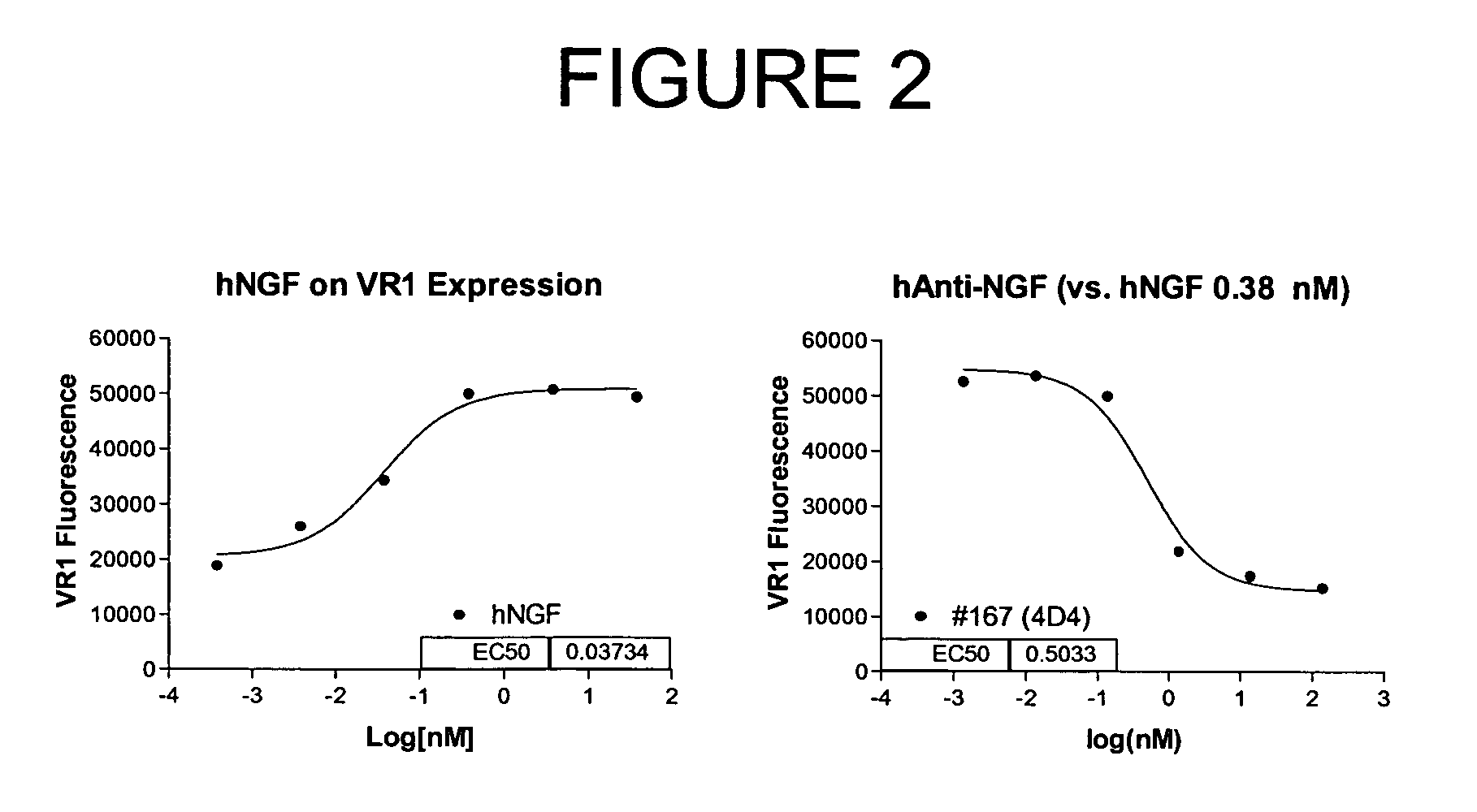Human anti-NGF neutralizing antibodies as selective NGF pathway inhibitors
a technology of ngf pathway and human monoclonal antibody, which is applied in the field of human monoclonal antibody, can solve the problems of gastrointestinal irritation, debilitating or dangerous side effects, and partial effectiveness, and achieve the effect of increasing ngf production and increasing sensitivity to ng
- Summary
- Abstract
- Description
- Claims
- Application Information
AI Technical Summary
Benefits of technology
Problems solved by technology
Method used
Image
Examples
example 1
Generation of Human NGF Protein from E. coli Cells
Cloning of rHu-NGF (1-120)
[0259]The nucleotide sequence encoding human NGF was amplified from cDNA using the oligonucleotide primers with sequences as shown in SEQ ID NO:27 and SEQ ID NO:28 and standard PCR technology. The 5′ primer creates an NdeI restriction site and methionine initiation codon immediately preceding codon 1 (serine) of the mature sequence. The 3′ primer creates a BamHI restriction site immediately following the termination codon. The resulting PCR product was gel purified, digested with restriction endonucleases NdeI and BamHI, and then ligated into the vector pCFM1656, also digested with NdeI and BamHI. Ligated DNA was transformed into competent host cells of E. coli strain 657. Clones were screened for the ability to produce the recombinant protein product and to possess a plasmid having the correct nucleotide sequence (i.e., SEQ ID NO:29). The amino acid sequence of the recombinant human NGF 1-120 is shown as SE...
example 2
Production of Human Monoclonal Antibodies Against Nerve Growth Factor (NGF)
Transgenic HuMab and KM Mice
[0264]Fully human monoclonal antibodies to NGF were prepared using HCo7, HCo12, HCo7+HCo12, and KM strains of transgenic mice, each of which expresses human antibody genes. In each of these mouse strains, the endogenous mouse kappa light chain gene has been homozygously disrupted as described in Chen et al. (1993, EMBO J. 12:811-820), and the endogenous mouse heavy chain gene has been homozygously disrupted as described in Example 1 of International Patent Application Publication No. WO 01 / 09187 (incorporated by reference). Each of these mouse strains carries a human kappa light chain transgene, KCo5, as described in Fishwild et al. (1996, Nature Biotechnology 14:845-851). The HCo7 strain carries the HCo7 human heavy chain transgene as described in U.S. Pat. Nos. 5,545,806, 5,625,825, and 5,545,807 (incorporated by reference). The HCo12 strain carries the HCo12 human heavy chain tr...
example 3
Selecting and Cloning Anti-NGF Antibodies with Potent NGF Neutralizing Activity
[0274]The effectiveness of the antibodies initially identified in Example 2 as inhibitors of NGF activity (i.e., NGF “neutralization”) was evaluated by measuring the ability of each modified peptide to block NGF induction of vanilloid receptor-1 (VR1) expression.
Dorsal Root Ganglion Neuronal Cultures
[0275]Dorsal root ganglia (DRG) were dissected one by one under aseptic conditions from all spinal segments of embryonic 19-day old (E19) rats that were surgically removed from the uterus of timed-pregnant, terminally anesthetized Sprague-Dawley rats (Charles River, Wilmington, Mass.). DRG were collected in ice-cold L-15 media (GibcoBRL, Grand Island, N.Y.) containing 5% heat inactivated horse serum (GibcoBRL), and any loose connective tissue and blood vessels were removed. The DRG were rinsed twice in Ca2+- and Mg2+-free Dulbecco's phosphate buffered saline (DPBS), pH 7.4 (GibcoBRL). The DRG were then dissoci...
PUM
 Login to View More
Login to View More Abstract
Description
Claims
Application Information
 Login to View More
Login to View More - R&D
- Intellectual Property
- Life Sciences
- Materials
- Tech Scout
- Unparalleled Data Quality
- Higher Quality Content
- 60% Fewer Hallucinations
Browse by: Latest US Patents, China's latest patents, Technical Efficacy Thesaurus, Application Domain, Technology Topic, Popular Technical Reports.
© 2025 PatSnap. All rights reserved.Legal|Privacy policy|Modern Slavery Act Transparency Statement|Sitemap|About US| Contact US: help@patsnap.com



